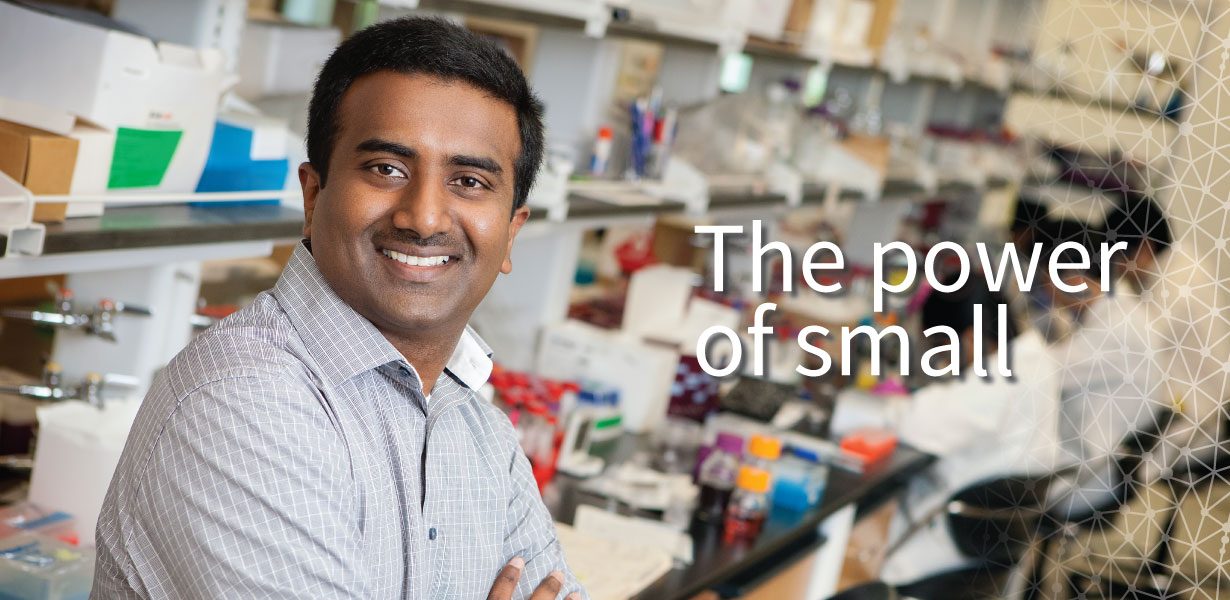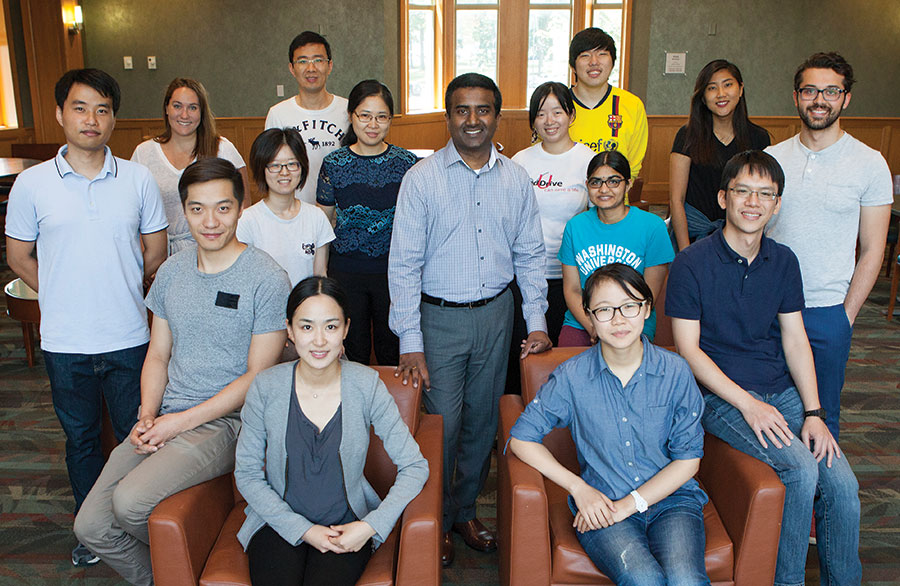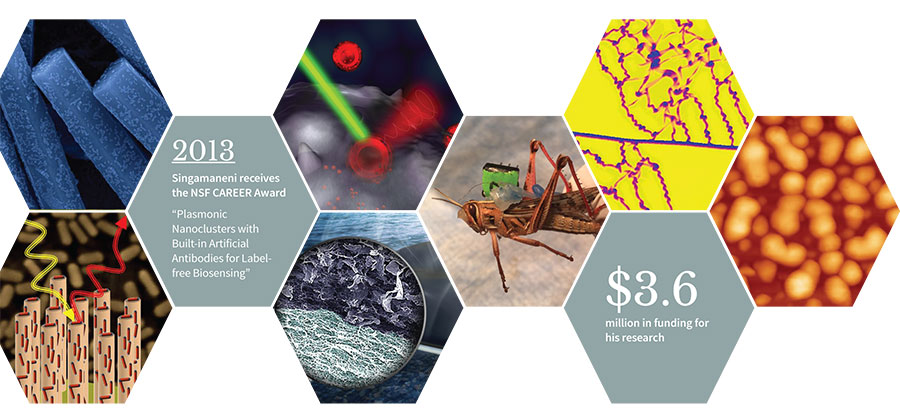The power of small
Srikanth Singamaneni

There’s a saying that doors will open to those bold enough to knock. Srikanth Singamaneni was bold enough to knock several times early in his career, which has helped him to make significant discoveries in materials science that are already making a mark in the world.
Singamaneni works with nanomaterials to create powerful sensors that can be used to detect chemicals and biomarkers that could speed health-care diagnostics and new materials to filter dirty water to make it potable. His work spans from nanomedicine to physics to biology, all from a materials science perspective. Most recently, he has added research into the interface between biotic and abiotic interfaces in an effort to create advanced functional materials at a very small scale — the nanoscale.
Since Singamaneni joined the School of Engineering & Applied Science faculty in January 2010, he has received more than $3.6 million in funding for his research, as well as a National Science Foundation CAREER Award, which is given to faculty early in their careers to jump-start their work, and a Dean’s Faculty Award for Innovation in Research. His research with plasmonic biosensors and bioinspired functional materials has been written about in the media worldwide, including in his hometown newspaper in a small village in southeast India.

Singamaneni has uncanny insight for using materials to solve problems. He recently combined a cellulose material created from bacteria with graphene oxide to make a biofoam that can purify dirty water using only sunlight as the trigger to start the process. Both materials are inexpensive and can be created on a large enough scale that the process is viable to purify water in developing countries with abundant sunlight.
He also has used biology and nature as inspiration for new materials, for instance, studying how the exoskeleton protects insects as a model for new materials to protect airmen in combat situations. He also is collaborating with Barani Raman, associate professor of biomedical engineering, and Shantanu Chakrabartty, professor of electrical & systems engineering, to develop bio-enabled sensors that could detect explosives and be used in other homeland security applications. He is collaborating with Young-Shin Jun, associate professor of energy, environmental & chemical engineering, to improve the performance of reverse osmosis membranes for water purification.
Singamaneni has other collaborations with a variety of faculty both in Engineering and in the School of Medicine, including Samuel Achilefu, the Michel M. Ter-Pogossian Professor of Radiology; and Evan Kharasch, MD, PhD, the Russell D. and Mary B. Shelden Professor of Anesthesiology, director of the Division of Clinical and Translational Research and former vice chancellor for research; and Jeremiah (Jerry) Morrissey, research professor of anesthesiology, with whom he collaborates on developing a test to quickly detect kidney injury or cancer using gold nanoparticles. That collaboration developed from knocking on Kharasch’s door, figuratively speaking.
"I felt that I had a technology that could be applied for biomarker detection, and I was looking for kidney cancer biomarkers," he said. "I did not know that Evan was then vice chancellor for research and had a tight schedule, so I just emailed him. We got together, and he brought Jerry with him. We put together a proposal and got funded."
“We could come up with our own ideas and execute them, and he almost never said no to any idea that we wanted to try. Yes, you get to fail, but that's the learning process. And you build confidence — you do this once, twice, thrice, and by the time you finish your PhD, you feel like you can conceive of an idea and execute it and write it up.”
— Srikanth Singamaneni
That work, which has been ongoing since 2012, continues to grow. Singamaneni said within the next four years, the team hopes to collect patient samples to test with their technology and compare them to the results produced by the gold-standard tests.
After earning a bachelor's degree in electrical engineering from Nagarjuna University, Singamaneni left India to get a master's degree in electrical engineering at Western Michigan University, where the culture was very different from the one he knew. For instance, he had only used the internet a couple of times before coming to the U.S. However, his determination to succeed led to a new direction.
"I was randomly knocking on professors' doors trying to find a grading position, and I did not realize that I'd gone into the materials part of the building," Singamaneni recalls. "I knocked on a professor's door, and he said he didn't have a grading or teaching position, but he did have a research position that required some level of electrical engineering expertise, so I told him I'd take it."
Singamaneni worked with atomic force microscopy for the professor, who then asked him to demonstrate ultrasonic force microscopy using some samples. He got interested in the samples, then got interested in the materials and decided to earn a doctorate in materials science at Georgia Institute of Technology (Georgia Tech), a powerhouse for materials science where Singamaneni thrived.

At Georgia Tech, he studied under Vladimir Tsukruk, the Dean's Distinguished Professor of Engineering, a founding director of Microanalysis Center and founding co-director of DoD BIONIC Center of Excellence, who quickly became Singamaneni's role model.
"What I admired most in this group is the freedom he provided to students," Singamaneni said.
Although Singamaneni's name and work have been shared worldwide, what drives him is a deep sense of giving.
"If you only think about yourself, that's not enough motivation for you to do good work," he said. "You care about society and care about giving something back, be it knowledge or some well-trained person that you are sending out, or great products that might come out of your lab. All of this has to be what you want to give. Once that feeling is there, you are caring about something bigger than just your career or yourself."
Back to Engineering Momentum